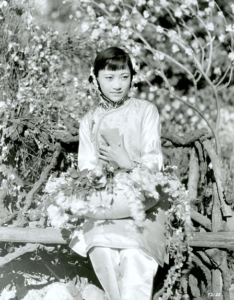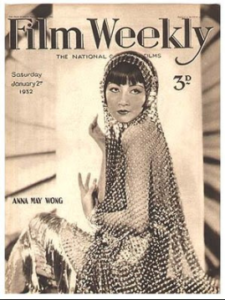In the best online art magazines, you’ll read about iconic actors like Katharine Hepburn and Cary Grant. However, in the early days of the movies, you can also see society’s opinions on race played out starkly on the silver screen. Blackface, yellowface, and every-other-color face was the norm. It took decades before actors of color got their shot, and white-washing remains a prominent issue. However, there were a few exceptions, and while she didn’t get the juicy roles she deserved, Anna May Wong stands out.
Starting out

Anna May Wong at 17-years old
Born in 1905, Anna May Wong’s Chinese name meant “yellow willow frost.” As a child, she lived among a variety of people, including the Japanese, Irish, and Germans. As a third-generation Chinese-American, Anna chose an Americanized name, but still faced intense discrimination at her school. One boy even poked her with needles. The taunting got so bad, she and her sister moved to a Chinese school that taught classes in English. On Saturdays, they attended Chinese school, but Anna preferred to skip and watch movies.
Having falling in love with film, Anna got her first role as an extra in The Red Lantern in 1919. In 1921, she dropped out of high school, and a year later, she landed the leading role in The Toll of the Sea. She was only 17. Critics loved her, and she acted in a few more films, often playing a sexy villainess. Censor laws at the time forbade interracial romance, so it was basically impossible for Anna to get a lead role, because that would require her to kiss her white male co-star. In 1928, she moved to Europe, which had much looser rules.
Losing The Good Earth
Anna May Wong lived in Berlin and acted with stars like Marlene Dietrich. When “talkies” began, she acted in English, German, and French. In 1931, Paramount offered her a contract, and the young actress returned to Hollywood. While the roles were bigger, they were still highly-eroticized and exoticized. However, when the leading role of “Star Blossom” came up, producers said she was “too Chinese.” Her career stalled again when white actress Luise Rainer got the leading role in The Good Earth, which tells the story of a Chinese rice farmer and his wife. Devastated, Anna refused to take the producers’ “consolation price:” the role of the dancer who seduces the film’s hero.

1932
Too Chinese and too American
Anna’s identity between two worlds became apparent when she visited China. While she received welcome in some areas, the Chinese government and many citizens didn’t like the “sexy vamp” roles she played. She seemed out of place in China, just as she did in America. She’s even quoted as saying, “It’s a pretty sad situation to be rejected by the Chinese because I am too American.” Her sister Mary experienced similar confusion and challenges as she attempted her own film career, and took her own life in 1940.
Last years and legacy
During WWII, Anna acted less and less. In the 1950’s, she hosted her own show for 13 weeks, making her the first Chinese-American in that role. After being cast in Rodgers and Hammerstein’s Flower Drum Song in 1961, she became ill before rehearsals. She died in her sleep of heart failure in 1961 at age 56.
During Anna May Wong’s career, fellow movie stars dressed up as her for costume parties, and claimed she held power over men with just a look. This “positive” racism remains common for Asian-Americans, but for all the admiration, it’s still challenging for them to find acting roles. In 2017, the film Ghost in the Shell came under fire for casting Scarlett Johansson in a role meant for a Japanese woman, while in The Last Airbender (2010), virtually the entire cast is white instead of the mix of Asian and Inuit depicted in the animated TV show. Anna May Wong broke barriers and fought stereotypes, but the film industry still has a long way to go.
Want more content from our best online art magazines? Here’s a list of female writers that also broke barriers against the odds.




